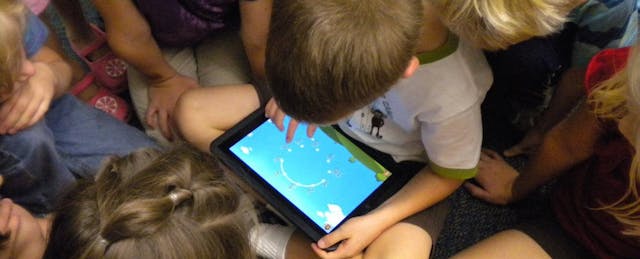Way back in 2002, when Friendster was the biggest social network and people were gathering in Internet cafes, the State of Maine implemented the first 1:1 laptop initiative in the country. All 7th and 8th grade students, and their teachers, were provided with Apple 12-inch iBooks. The computers were equipped with educational software and wireless connectivity.
The MLTI (Maine Learning Technology Initiative) program coevolved with the technology available. Over one-half of participating school districts allowed students to take home their laptops by 2004; a second RFP was issued in 2006; and the MLTI program expanded into high schools in 2009. In 2013, school districts were given the option to participate in one of five solutions, which included Apple laptops, Hewlett-Packard laptops, and iPads. Approximately 60% of the participating districts chose iPads.
In May of this year, the Maine Learning Technology Initiative (MLTI) program offered schools the opportunity to “refresh” their Apple devices, i.e. turn in their devices for newer models, including the iPad Pro. Schools could also opt to move from an Apple laptop option to an iPad option—or vice versa.
As has been reported, a number of districts opted to move back to laptops from iPads.
So, what happened?
The iPad’s “Reported” Issues
The biggest challenges with the iPad as cited by teachers were class management and the need for lesson design.
But with new digital tools comes new forms of learning experiences, and new learning experiences require addressing class management head-on. Mirna Reyes-Henderson, a world language teacher and department head at Foxcroft Academy, points out that good classroom management includes using the iPad as a tool to reinforce classroom learning and interaction. The iPad does not direct the education—the teacher does.
But here’s the thing: Successful integration of the iPad into the classroom does require the development of a new mindset of student-centered learning and creation. Student-centered learning and creation is not limited to the iPad classroom, but the iPad does provide features that make it a valuable tool for learning.
From the Maine Educators: Why I Still Love the iPad
Versatility
Shawn Carlson, Assistant Superintendent for Technology, Curriculum and Instruction in Boothbay, Maine points out features which have made iPad implementation successful in his school district. Here are five:
- Mobility: Students can take an iPad anywhere.
- Accessibility: The iPad includes built-in features like text-to speech, dictation, and word prediction.
- Recording Features: There are built-in cameras and microphones.
- Screenshare: The iPad includes “Airplay” to allow screen-sharing with the class.
- Airdrop: Users can share files or quickly move them to another device for collaborative editing.
Features That Support Student-Directed Learning
Reyes-Henderson of Foxcroft Academy works at the first high school in Maine to implement a 1:1 iPad initiative, dating back to the fall of 2012. She points out that the audio feature has changed her classroom; not only can she record herself for her students to hear, but more importantly her students can record themselves. Because of this, students develop better speaking skills when they can listen to—and correct—themselves. Self-training apps on the iPad allow students to practice outside of the classroom and increased the amount of time students spend practicing. And that practice translates (yes, pun intended) into greater development of fluency.
Reyes-Henderson also reports that students enjoy the hands-on learning. In fact, she’s not the only one to highlight the movement away from worksheets and toward greater creation. Back at Boothbay, students have created a variety of products to demonstrate their learning (e.g. animations, blog posts, radio theater) for a real audience, not just the teacher. In fact, assistant Superintendent Shawn Carlson points out the one of the most successful uses of iPads in Boothbay has been in assessments. iPads allow students to easily collect images, audio, or video of student work and performances—all on the fly—which can then be preserved in digital portfolios.
21st Century Skills
Similar to Ann Luginbuhl, a middle school teacher at Charlotte Elementary School in downeast Maine, has found that iPads encourage 21st century forms of communication, pointing out that students are not growing up in a world where written communication will be the default; they need to be encouraged to use audio, video, and images to communicate effectively.
Luginbuhl finds that the iPad makes these important kinds of communication easy to generate. She is excited to be refreshing with iPads—and Reyes-Henderson and Carlson both agree.
From the beginning of the MLTI program, the focus has been on learning with technology providing a tool to meet the learning objective. As technology evolves, deeper thought about learning and lesson design is needed. Teachers will require time, and professional development around this new mindset, to create powerful new learning experiences for their students. That’s not specific to the iPad—that comes with the introduction of any new device. And because of that, it’s too early to lose hope for this flat, digital piece of technology.


